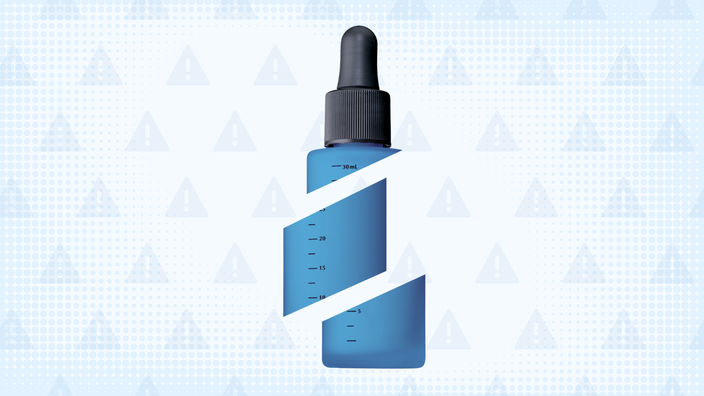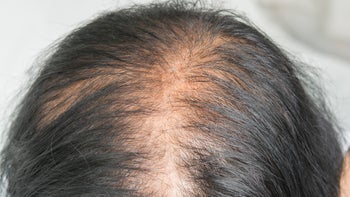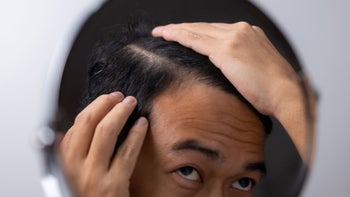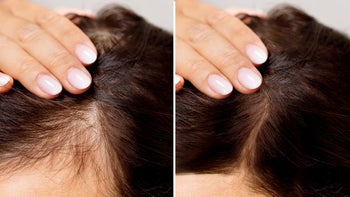
5 Topical Minoxidil Side Effects You Should Know About
Key takeaways:
Topical minoxidil (Rogaine) is an over-the-counter product that’s marketed to treat hair loss in men and women. It comes as a foam and as a liquid solution.
Topical minoxidil is generally well tolerated. It can cause temporary hair shedding, scalp irritation, and changes in hair texture. In rare cases, it can contribute to a fast heartbeat.
Some topical minoxidil side effects can be avoided by taking the low-dose tablet formulation. However, minoxidil tablets are only available with a prescription from a healthcare professional. The tablets also come with their own side effects.
Access savings on related medications
Table of contents

If you’ve looked in the mirror and noticed that your hair is thinning, you may be looking for a way to slow down or reverse your symptoms. Thankfully, there’s good news — many hair loss remedies are available for purchase.
One go-to hair loss treatment is minoxidil. It comes as an over-the-counter (OTC) liquid solution or foam that you apply to your scalp. You can find it at drugstores under the brand name Rogaine. Several generic equivalents are available as well. A prescription-only oral tablet is another option. Oral minoxidil is only approved to treat high blood pressure, so using it for hair loss is an off-label use.
In many cases, people don’t experience any side effects from topical minoxidil. It’s generally safe, well tolerated, and effective for treating hair loss. But, as with all medications, there are some potential side effects to keep in mind when using topical minoxidil.
Get Exclusive Savings on Toprol XL (metoprolol ER)
With GoodRx you can save big on Toprol XL.

GoodRx is NOT insurance. GoodRx Health information and resources are reviewed by our editorial staff with medical and healthcare policy and pricing experience. See our editorial policy for more detail. We also provide access to services offered by GoodRx and our partners when we think these services might be useful to our visitors. We may receive compensation when a user decides to leverage these services, but making them available does not influence the medical content our editorial staff provides.
© 2025 Melinta Therapeutics, LLC All rights reserved 5/2025 PP-TOP-US-0017
Topical minoxidil side effects at a glance
Most of topical minoxidil’s side effects are limited to the skin. Beyond your skin, your body only absorbs small amounts of minoxidil. Because of this, it’s not typical to experience whole-body side effects. But, it can happen in some cases, especially when minoxidil is used too much.
Some common topical minoxidil side effects include:
Increased hair shedding (during the first few weeks of treatment)
Scalp irritation
Dryness or dandruff-like flakes
Changes in hair texture or color
Greasy or sticky residue on the scalp
Unwanted hair growth (if minoxidil spreads to other areas like the forehead or face)
Headaches
Rare but potentially serious risks may include:
Dizziness or lightheadedness
Chest pain
Swelling in the hands or feet (edema)
Unexplained weight gain
Allergic reactions, including rashes, swelling, or severe itching
Difficulty breathing
Here, we’ll dive deeper into five notable side effects of topical minoxidil.
1. Initial hair shedding
While you’re likely using minoxidil to regrow your hair, you may initially experience hair shedding — the opposite of what you want. But don’t worry. This is common and expected.
This happens because your hair doesn’t grow at a steady rate. It goes through growth and resting phases. Topical minoxidil works by reducing the length of the resting phase and increasing the length of the growth phase. When the resting phase is shortened, this can initially cause you to shed your hair. Thankfully, it’s soon replaced by new, thicker hair.
Over time, hair shedding shouldn’t be an issue. Many people see hair growth with topical minoxidil after about 16 weeks (4 months). However, results and timing vary for everyone.
How long do hair-loss medications take to work? It can take several months to see results, but how long exactly depends on the specific treatment.
Natural remedies for hair loss: Some people might be hesitant to try medications for hair loss. These natural remedies might help support hair health, but there isn’t enough research to know for sure.
Side effects: Finasteride (Propecia) can cause side effects too. Learn from pharmacists about which ones to watch for.
2. Scalp irritation
While the initial hair shedding may leave you scratching your head, there’s also a chance you may be doing so because of a dry, itchy scalp — one of topical minoxidil’s most common side effects.
One of the ingredients in the liquid formulation of topical minoxidil is propylene glycol. Many people who have a skin reaction to topical minoxidil may actually be experiencing an allergic reaction to propylene glycol. If you experience this side effect when using liquid minoxidil, you might want to consider using the foam instead. This formulation typically does not contain propylene glycol. If you still experience an allergic reaction, you may be allergic to minoxidil itself or one of the other inactive ingredients.
Liquid topical minoxidil may also cause temporary scalp irritation. If it doesn’t resolve on its own, you should stop using the medication. Alternatively, you might consider trying a different form of minoxidil, like the foam, or asking your healthcare professional about the oral tablets.
3. Unwanted hair growth
While minoxidil is effective for regrowing hair, it might also cause you to grow hair where you don’t want it. This seems to be more common in women than in men.
On the plus side, this doesn’t happen very often. In one study, about 4% of women experienced facial hair growth while using topical minoxidil on their head.
Thankfully, this type of hair growth isn’t permanent. It’s usually reversible. If you notice unwanted facial hair after applying minoxidil, you can simply stop applying it. Over time, the unwanted hair should disappear on its own.
4. Hair texture changes
In some cases, you may see changes in your hair texture after starting topical minoxidil. You may welcome these changes if you’re seeing stronger, thicker hair come in. But you might also notice your hair changing colors or becoming wavy if it was previously straight.
If you notice any hair changes that you’re dissatisfied with, reach out to your healthcare professional. They can help you decide if an alternative hair loss remedy might be better for you.
5. Rare systemic side effects, like a fast heartbeat
Most of topical minoxidil’s side effects happen in the area where it’s applied. About 99% of the medication’s effects are local to your skin. And of the 1% of the medication that is absorbed into your system, almost all of it is removed by your kidneys within 4 days. This helps prevent systemic side effects.
In very rare cases, though, topical minoxidil can seep deeper into your body and cause systemic side effects. You should stop applying minoxidil if you experience chest pain, a rapid heartbeat, fainting, or dizziness. As a precaution, if you have a heart condition, you should talk to a healthcare professional before using minoxidil to make sure it’s OK for you to use.
Systemic side effects are more likely with oral minoxidil. But dosages play a role. As mentioned above, oral minoxidil is used to treat high blood pressure at normal dosages. It circulates in your bloodstream and affects some of your organs, including your heart. When oral minoxidil is used in lower doses to treat hair loss, its effects are less pronounced.
Frequently asked questions
Minoxidil can help regrow hair and slow hair loss. But its effects aren't permanent. If you stop using it, any new hair growth may gradually fall out. Hair loss can continue as before. For best results, use topical minoxidil consistently as part of a long-term hair care routine.
Yes, topical minoxidil can sometimes cause dandruff or a dry, flaky scalp. This is usually due to the alcohol content in some minoxidil solutions. To help prevent this, you can try using a moisturizing shampoo, switching to minoxidil foam, or applying a scalp conditioner.
The bottom line
The most common topical minoxidil (Rogaine) side effects are hair shedding and scalp irritation. However, minoxidil topical solution and foam are generally considered safe and effective for treating hair loss in men and women. Many of these side effects go away after you stop using the medication. And some can be avoided by using different forms of minoxidil.
Why trust our experts?



References
Dawber, R. P. R., et al. (2003). Hypertrichosis in females applying minoxidil topical solution and in normal controls. Journal of the European Academy of Dermatology & Venereology.
Gomes, Á. K. G., et al. (2021). Androgenic alopecia: The use of minoxidil and it’s adverse effects. Research, Society, and Development.
Johnson & Johnson. (2020). Men’s Rogaine 5% minoxidil topical aerosol [package insert].
Olsen, E. A., et al. (2007). A multicenter, randomized, placebo-controlled, double-blind clinical trial of a novel formulation of 5% minoxidil topical foam versus placebo in the treatment of androgenetic alopecia in men. Journal of the American Academy of Dermatology.
Patel, P., et al. (2023). Minoxidil. StatPearls.
Ponomareva, M. A., et al. (2024). Topical minoxidil overdose in a young man with androgenetic alopecia: A case report. Cureus.
Randolph. M., et al. (2020). Oral minoxidil treatment for hair loss: A review of efficacy and safety. Journal of the American Academy of Dermatology.
Rossi, A., et al. (2012). Minoxidil use in dermatology, side effects and recent patents. Recent Patents on Inflammation & Allergy Drug Discovery.
Schurr, L., et al. (2022). Contact allergy to propylene glycol. DermNet.
Suchonwanit, P., et al. (2019). Minoxidil and its use in hair disorders: A review. Drug Design, Development and Therapy.
Was this page helpful?
Related Articles
Browse medications
View AllResearch prescriptions and over-the-counter medications from A to Z, compare drug prices, and start saving.













